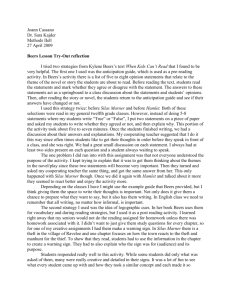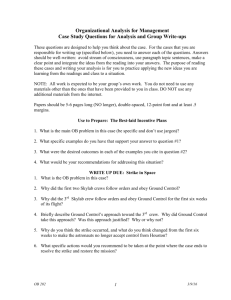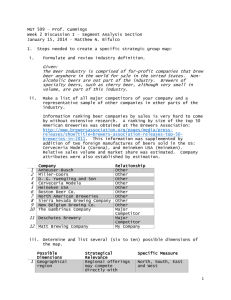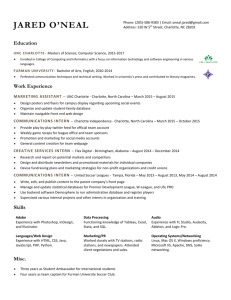Leading Change - Faculty Directory | Berkeley-Haas
advertisement
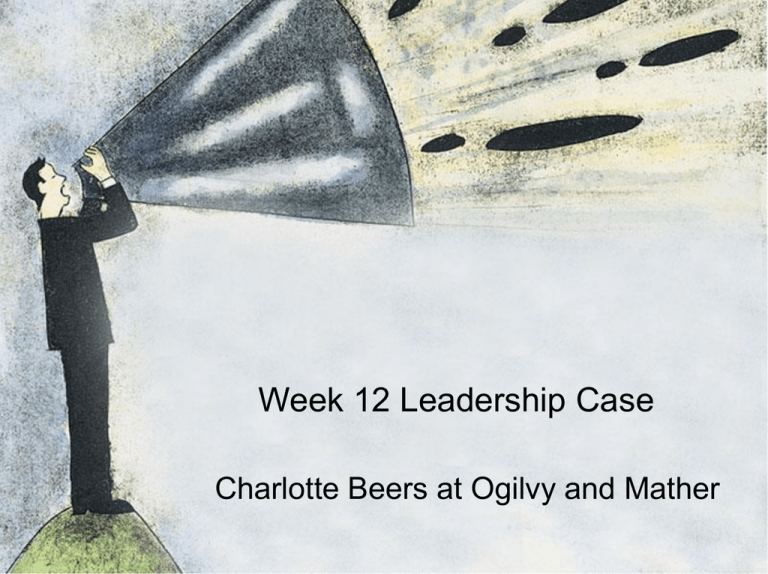
Week 12 Leadership Case Charlotte Beers at Ogilvy and Mather Changing Industry Context since mid-1980s Decrease in media-related expenditure (traditionally the biggest revenue generator for ad agencies). Shifting of marketing effort to new channels (direct, telemarking, promotions). Changes in how ad work is compensated by clients Merger and acquisition Globalization of clients April 12, 2005, Waverly Charlotte Beers at O&M 2 Internal Challenge Multi-local structure breed local autonomy—structure is not optimized to serve multinational clients. Success breed strong, arrogant culture; managers internally focused. Lack of inspirational leaders since the retirement of the founder. Strong managerial and financial discipline imposed after 1989 WPP acquisition—exodus of creative and account talents. April 12, 2005, Waverly Charlotte Beers at O&M 3 Direction Setting: Did Beers have a good vision? New direction: brand stewardship “To be the agency most valued by those who most value brands” Two main tenets of brand stewardship – Companies can only compete in the long term by building strong brands – Role and value of advertising is to build brands by uncovering the rational and emotional significance of a product in users’ life Strategy: how to get there? – Brand probe – Brand Audit – Brand Print April 12, 2005, Waverly Charlotte Beers at O&M 4 Direction Setting: Did Beers have a good vision? Clarity: – Is it clear and specific enough to provide guidance, and at the same time vague enough to encourage initiatives and remain relevant under varied conditions? Desirability: meets the needs of key stakeholders – – – – – Enthusiasm from clients Account managers like it Top creative people are on board Resistance from local creative people: see it as constraining Not much offer to the Direct Marketing division Feasibility: – Provide the rationale to offer integrated services to clients – Leverage O&M’s worldwide presence and strong global network – Instrumental in reigning in local fiefdoms April 12, 2005, Waverly Charlotte Beers at O&M 5 Direction Setting: Did Beers have a good vision? Originality: Is it original? How important is originality? – Not that original: similar to the one-bundle service strategy the firm tried to implement earlier – Most other major advertising agencies were focusing on brands as well – But this is not important: most effective visions are not original at all. April 12, 2005, Waverly Charlotte Beers at O&M 6 Assessment of the Direction Setting Process Questions to think about in assessing the process: – Was it high involvement? Or was it mostly done by herself? – Did she involve the right number of people at each stage? – How effective was she in dealing with internal resistance? – How did she manage to maintain room for creativity while setting a direction? April 12, 2005, Waverly Charlotte Beers at O&M 7 Beers’ Direction Setting Process Start with her own vision of brand-driven advertising agency model Select a small group of managers (The Thirsty for Change) and have the idea debated among them Involve a larger group of managers to further refine the vision and the strategy More directive at the beginning (Vienna meeting), but more participative at a later stage (Westchester meeting) Establish WCS: structurally prepare for the implementation of the vision April 12, 2005, Waverly Charlotte Beers at O&M 8 Communication of the vision Why were there resistance? – Misunderstanding or lack of trust: e.g., some local creative people believe that the new vision is to impose constraints on them – Parochial self-interest: the fight over billings and fees between local offices and WCS – Different assessment: not everyone if the firm has the same degree of urgency – Low tolerance for change: e.g., some people view doing a brand audit on existing business as an indictment of what they have been doing April 12, 2005, Waverly Charlotte Beers at O&M 9 Communication of the vision How to overcome resistance? – – – – – April 12, 2005, Waverly Education and communications Participation Negotiation Explicit and implicit coercion Structurally align the organization with the new mission (e.g., create WCS) Charlotte Beers at O&M 10 Process of Renewing and Transforming Organizations (Kotter Leading Change 1995) 1.Establishing a Greater Sense of Urgency • Getting people to examine seriously the competitive realities • Identifying crises, potential crises or major opportunities 2. Creating the Guiding Coalition • Putting together a group with enough power to lead the change • Getting the group to work together like a team 3. Establishing a Transformational Vision and Strategy • Creating a vision to help direct the change effort • Developing strategies for achieving that vision 4. Communicating the Change Vision • Using every vehicle possible to constantly communicate the vision and strategies • Role modeling needed behavior by the guiding coalition April 12, 2005, Waverly Charlotte Beers at O&M 11 Process of Renewing and Transforming Organizations (Kotter Leading Change 1995) 5. Empowering Others to Act • Getting rid of blockers • Change systems or structures that seriously undermine the change vision • Encouraging risk taking and nontraditional ideas, activities, and actions 6. Creating Short-Term Wins • • Planning for some visible performance improvements Visibly recognizing and rewarding people who made the wins possible 7. Consolidating Gains and Producing Even More Change • Using increased credibility to change all systems, structures and policies that don’t fit together or don’t fit the transformation vision • Hiring, promoting and developing people who can implement the change vision • Reinvigorating the process with new projects, themes, and change agents 8. Institutionalizing New Approaches into the Org. Culture • Creating better performance through customer and productivity oriented behavior, more and better leadership, and more effective management • Articulating the connections between new behavior and firm success • Developing means to ensure leadership development and succession April 12, 2005, Waverly Charlotte Beers at O&M 12
